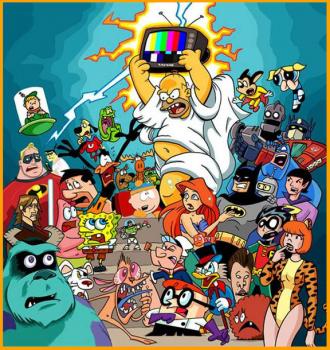
41. In 1941, Leon Schlesinger, producer of the Looney Tunes, fired Tex Avery after a dispute regarding the ending of “Heckling Hare.” You know what they say, when a door closes, MGM hires you to open a new door to your very own Animation unit!
42. Harry Smith experiments with animation, painting and manipulating by hand directly on celluloid within the themes of surrealism and dada. Not for everyone, but influential on Animation for thinking outside of the box with techniques.
43. During the big experimental boom of Animation, up in grand ol’ Canada, filmmaker Norman McLaren produces “one of the most controversial films the NFB (National Film Board of Canada) has ever made.” “Neighbours” uses the stop-motion technique of “Pixilation”- using live actors, moving them ever-so slightly frame by frame to capture movement. McLaren also created the soundtrack by scratching the edge of the film.
44. The creation of “Pixilation” allowed it’s creators to use actors as a living stop-motion puppet. The Bolex Brothers used it in “The Secret of Tom Thumb” to create a compellingly eerie effect. The term is widely credited to Grant Munro with his experimental movie named “Pixillation”.
45. UPA (less known as the United Productions of America” signs a contract with Columbia to make 4 theatrical cartoons. With the success of the cartoons, they were able to call Columbia home to create their innovative and modern approach to Animation.
46. By 1950, animated commercials were becoming progressively expected in television, so obviously it is time for something longer than 30 seconds hence “Crusader Rabbit” was born. It was the first limited animation cartoon made for the tube. It lasted a whopping 5 minutes and included 90 seconds of commercials.
47. It didn’t take long from first need to IBM launching the FIRST computer system, the IBM 701, in 1952. Nineteen of them were sold at an unbelievable price. Near the end of the 60’s, the software cost hundreds of thousands of dollars for a single terminal.
48. A year later, back in TV land, the addition of “Interactive” comes around. “Winky Dink and You” encouraged kids to draw along at home by placing a sheet of places over the TV screen. The show also included limited amount of animation in it.
49. UPA was thriving through the 50’s and cultivated in creating the first 30 minute show for CBS, “The Gerald McBoing Boing Show.” It also was padded with older UPA cartoons.
50. In 1956, Floyd Norman becomes the first African American artist at Disney, animating beloved films such as The Sword in the Stone and The Jungle Book! He later went on to start his own Animation studio, Afrokids, and is still out there being creative in children’s books, comics, and story art for Pixar.
51. With computers even younger than Animation at this point, strides are in motion. Analog Computer Graphics come around in 1957 when John Whitney combines 17 Bodine motors, 8 Selsyns, 9 different gear units and 5 ball integrators. He later went on to use this to create film and television title sequences including in collaboration and art direction with Saul Bass the titles intro to Alfred Hitchcock’s “Vertigo.”
52. With tons of short animated cartoons being contracted by studios for release alongside theatre releases and television, Columbia re-releases old cartoons alongside the all new half-hour cartoon show, “The Huckleberry Hound Show.” It’s set up include three short segments of adventures with either Huckleberry Hound, Yogi Bear, and Pixie and Dixie.
53. Times begin to change and the first TV series to be animated abroad happens at a studio in Mexico. “Rocky and Bullwinkle” win this…um… honor. It is not only the beginning of animation being sent “overseas” but also the beginning of a long term problem with “quality control.”
54. Up until 1960’s, the animation that appears on television is mainly shorter cartoons in a variety half-hour series. Hanna—Barbera’s “The Flintstones” changes that by telling one full story and is the first prime time animated series.
55. Hopping back over to the beginnings of Computers, Ivan Sutherland and SKETCHPAD at MIT/Lincoln Labs are busy at work engineering away. With their discoveries, Ken Knowlton over at Bell Laboratories in 1964, begins developing computer techniques that will produce animated movies… you know, one day.
56. Same year, Walt Disney releases the beloved “Marry Poppins” which is the first feature to use a sodium loss process to make special effects mattes.
57. Popular culture in the 60’s had a great deal of hype created by the Beatles that was heightened even further by the release of “The Yellow Submarine”. It revitalizes the animated commercial industry when sponsors demand their advertisements to look like the film.
58. Shortly after “The Yellow Submarine” is released, it reaches Singapore as so does the first animation riot. The audience believed they were paying to see a live show. With disappointment the fans destroyed the theatre.
59. In 1969, Sesame Street hits the small screen from the mind of Jim Henson. They support independent animators and studios and create a market for their unique style of animation in segments suitable for children’s television.
60. Just when animation was becoming children’s play, Ralph Bakshi creates the first X-rated animated feature, “Fritz the Cat”. The film includes cat orgies… and get this, it had a successful release in US. Forever proof of how progressive the US is?
